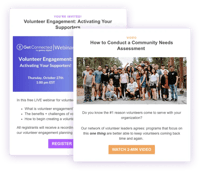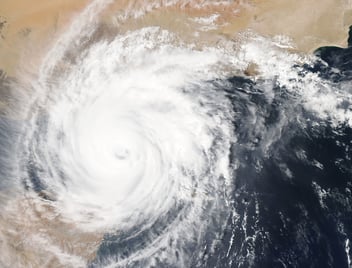Free Disaster Response Toolkit
The United States has experienced a sizable influx of billion dollar disasters in recent years. According to the National Oceanic and Atmospheric Administration (NOAA), the United States endured two catastrophic storms between January and April 2019 alone. Between 1980 and 2013, the U.S. averaged roughly six large-scale disasters per year. Over the past five years, that number has spiked to more than twelve. In 2018 alone, it’s estimated that natural disasters cost the U.S. $100 billion and killed nearly 250 people.
When these disasters strike, disaster relief organizations deploy to affected communities. They typically work closely with community leaders to identify and prioritize humanitarian needs like rescuing and treating victims, providing temporary shelter, serving warm meals, providing trauma counseling, or distributing hygiene kits. Many disaster agencies maintain a presence through the response, recovery, and mitigation phases following an emergency.
Whether you’re a nonprofit who wants to partner with these disaster response groups, or a citizen searching for volunteer opportunities, the following list will help you identify domestic and international disaster relief organizations. While this is not an exhaustive list, it’s a good place to get started.
International Disaster Relief Organizations
There are many international humanitarian organizations that focus on disaster relief work. These organizations are all unique, each bringing different skills and resources to enhance the community’s response and recovery operations.
- All Hands Volunteers – All Hands Volunteers’s mission is to meet the short and long term needs of disaster-affected communities. They work alongside community members to build disaster-resilient schools, homes, and infrastructure. Over the course of 15 years, All Hands Volunteers has provided disaster relief support to over 1.1 million people around the world.
- Direct Relief International – Direct Relief is one of the top humanitarian aid organizations. It’s active in all 50 states and 70 countries and has a mission to improve the health and lives of people affected by poverty or emergencies. They work closely with affected communities to determine where and how to deploy medical resources in order to save the most lives.
- The World Vision – The World Vision is a Christian humanitarian organization. It trains and mobilizes community-based volunteers in major response and recovery activities; provides consultant services to local unaffiliated churches and Christian charities; and collects, manages, and organizes goods for distribution to affected communities.
- The REACT International – REACT International provides emergency communication facilities for other relief organizations. Their network of committed communications professionals assists communities in times of emergency and disaster. REACT teams are encouraged to become part of their local disaster preparedness plan.
- The American Red Cross – The American Red Cross works to ease disaster-related suffering through humanitarian assistance and disaster relief initiatives. ARC’s emergency assistance includes feeding stations, first aid, temporary shelter, cleaning supplies, hygiene kits, food, clothing, emergency transportation, home repairs, and medical supplies. Handling both small house fires and large-scale natural disasters, ARC deploys as necessary to make sure people have clean water, safe shelter, and hot meals during times of need.
- The Salvation Army – The Salvation Army is one of the largest disaster relief organizations in the world. They provide emergency assistance including mass and mobile feeding, temporary shelter, counseling, search and rescue, medical assistance, and resource distribution.
Download the free disaster response toolkit
National Disaster Relief Organizations
Plenty of natural disaster relief organizations operate within the United States. These organizations, whether generalized or specialized, are poised to respond whenever a national disaster strikes.
- SBP – SBP was founded in 2006 after Hurricane Katrina. Its main objective is to shrink the time between the initial disaster and the recovery phase. SBP has a five part mission: to rebuild efficiently, to share their model with other organizations, to prepare homes and businesses through resilience training, to advise municipal and state officials, and to advocate for policy changes to improve disaster recovery. With the help of thousands of AmeriCorps volunteers, SBP rebuilds homes far below the market price following disasters.
- The National Organization for Victim Assistance – NOVA provides trauma mitigation services for individuals and families who experience trauma after the disaster. Most NOVA teams receive extensive training in critical events, from mass shootings to natural disasters.
- AmeriCares – AmeriCares has three main objectives in times of disaster: ready, respond and recover. By working with local government and health sectors, AmeriCares tries to prepare community hospitals and distribute medical supplies so they can provide as much life-saving care as possible. AmeriCares remains in the disaster-affected area until the health system recovers.
Flood Relief Organizations
- Team Rubicon – Team Rubicon has responded to over 80 flood-related disasters. Unique in the world of disaster relief, Team Rubicon combines the skills of military veterans with those of first responders and medical professionals. Founded by two marines, Team Rubicon also helps veterans transition from military to civilian life. Deploying both domestically and abroad, this humanitarian organization has operated in areas considered too dangerous by other disaster relief organizations. They respond to a wide range of disasters, from flooding to earthquakes.
Earthquake Relief Organizations
- UNICEF– UNICEF responds to both domestic and international emergencies. Recently, UNICEF has provided critical aid to earthquake victims in Mexico, Ecuador, Nepal, Haiti, the Philippines, and Japan. UNICEF provides both short and long-term necessities like food, water, shelter, healthcare, and mental health counseling whenever an earthquake or other disaster strikes.
Download your FREE disaster response toolkit >>
Faith-Based and Christian Disaster Relief Organizations
- Samaritan’s Purse – This non-denominational Christian organization provides spiritual and physical aid to people affected by disaster and poverty around the world. It focuses on helping victims of war, poverty, natural disasters and famine. Samaritan’s Purse programs include agricultural assistance, educational training, construction projects, clean water and sanitation, and women’s programs.
- NECHAMA – NECHAMA is a voluntary organization that provides natural disaster preparedness, response and recovery services. Its work surrounds the Jewish value of Tikkun Olam (“Repairing the world through acts of kindness”). NECHAMA trains and equips volunteers to assist disaster survivors with cleanup, debris removal, clean and sanitize homes, hang sheetrock, paint, replace flooring and more.
- Children’s Disaster Services (CDS) – CDS provides childcare in shelters and disaster assistance centers.Trained, certified volunteers respond to traumatized children with a calm, safe and reassuring presence.
- The Volunteers of America – is involved in initial response services aimed at meeting the critical needs of disaster victims.
- The Friends Disaster Service (FDS) – FDS provides clean-up and rebuilding assistance to elderly, disabled, low-income, or uninsured survivors of disasters, regardless of faith, race, or ethnicity. While they are not first responders, they offer disaster clean-up assistance. In most cases, FDS is unable to provide building materials and, therefore, looks to other relief organizations for these supplies.
Get Involved
Due to increasingly volatile weather patterns, natural disasters are going to continue to plague the United States and abroad. Disaster response volunteers can play a key role in preparing for disasters and mitigating their impact. Engaged citizens can use this list to find organizations to contribute time or donate money and supplies to. Government disaster management agencies and related nonprofits should consider a disaster management software like ReDI to help them activate and manage qualified volunteers in disaster scenarios. Streamlined volunteer management among all organizations responding to a disaster can help increase impact and ensure the safety of volunteers.


Join 20,000+ Volunteer Leaders
Get impact-boosting articles, guides, and webinar invites to help grow your volunteer program
Whether you are a government disaster management agencies, a nonprofit involved in disaster response, or an engaged citizen, it is important to be familiar with these major disaster relief organizations. Knowing the key organizations involved in disaster response can help know what to do when disaster strikes.





